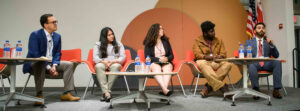How do students spend their time in class? To find out, we turned to an unlikely technology: potty-training watches.
Confused by the high number of students who take remedial courses in college, we wanted to know what they were doing in school in the twelve years prior. This question resulted in our most recent national report, The Opportunity Myth.
The report has always been a study of time: how students are spending their time, why some students spend their time differently than others, and the extent to which these choices relate to student outcomes. We knew we could tell one part of the story through the assignments teachers give and the instruction they lead. But we also knew our story would be incomplete if we stopped there—it would be missing the main characters. That’s because examining what students are asked to do or how they’re taught does not reveal anything about how they perceive their time in the classroom. We didn’t want to assume specific assignments engaged students because we saw value in them; we wanted to let students tell us themselves.
We weren’t the first to wonder how young people perceive their day-to-day or moment-to-moment experiences. We were inspired by the pioneering work of psychologist Mihaly Csikszentmihalyi, who studied engagement by prompting participants to take a survey about what they were doing and how they felt about it at random points during the day. The technique is known as the Experiencing Sampling Method or ESM, and it has successfully been used with adolescents to learn about their experiences.
ESM seemed right up our alley for The Opportunity Myth. It offered a chance to hear directly from students in real time and compare what and how they felt to the choices teachers and schools made. That’s where the potty-training watches came in.
We gave thousands of middle and high school students a wristwatch we had programmed to vibrate at a random point in class. When it vibrated, students knew it was their turn to complete a short survey asking how much they were concentrating, enjoying what they were doing, and interested in it—the three characteristics that define what it means to be engaged.
What students shared was revealing. They considered only about half of their experiences engaging. And they became increasingly less engaged as they progressed through their education: High school students reported being disengaged nearly 60 percent of the time.
Few people who read The Opportunity Myth are surprised by this, which highlights the unnerving reality that we’ve come to accept disengagement in school, especially high school, as a given.
That doesn’t have to be the case. In every district we studied, we saw counterexamples: classrooms where students were engaged most of the time, where they were both challenged and enjoying their learning. And we saw that instruction influenced engagement; in classrooms with stronger instruction, engagement levels were higher.
More importantly, The Opportunity Myth showed us that student engagement—or lack thereof—shouldn’t be kept under wraps. It is possible for schools and districts to give students opportunities to share how they perceive school and to use that information to make positive changes. And you don’t need the wristwatches to do it. We’ve put a version of our student survey on our toolkit that teachers can give to students at the end of the class each day, and made it freely accessible. We’ve also included a scoring guide, to help you determine when a survey response represents an engaging experience. The survey is appropriate for any student in third grade or above.
But the work is far from over. We’re continuing to adjust the survey and are building electronic versions so we can replicate the study without the need to program thousands of watches. Furthermore, we’re already working with and hearing from educators who are using student input as well as the findings from The Opportunity Myth to adjust their practice and engage students in more meaningful and relevant ways.
We’re taking these steps because students have the right to speak up about their education—the watches are just one way to get there.




